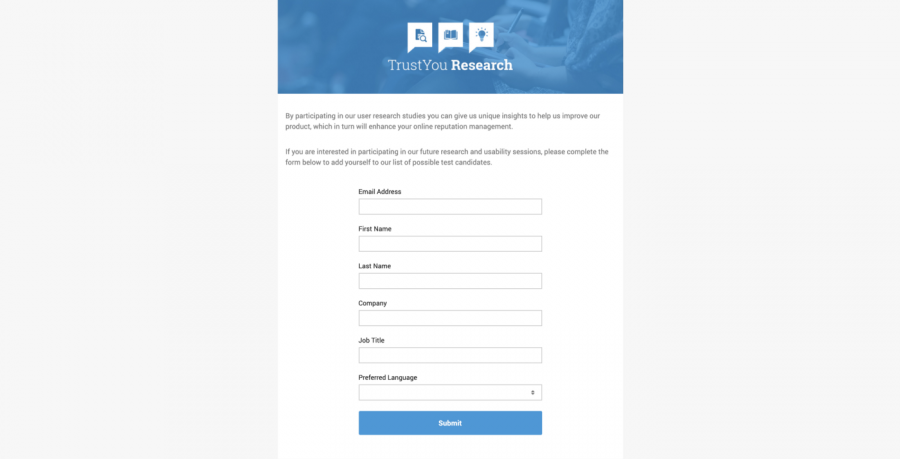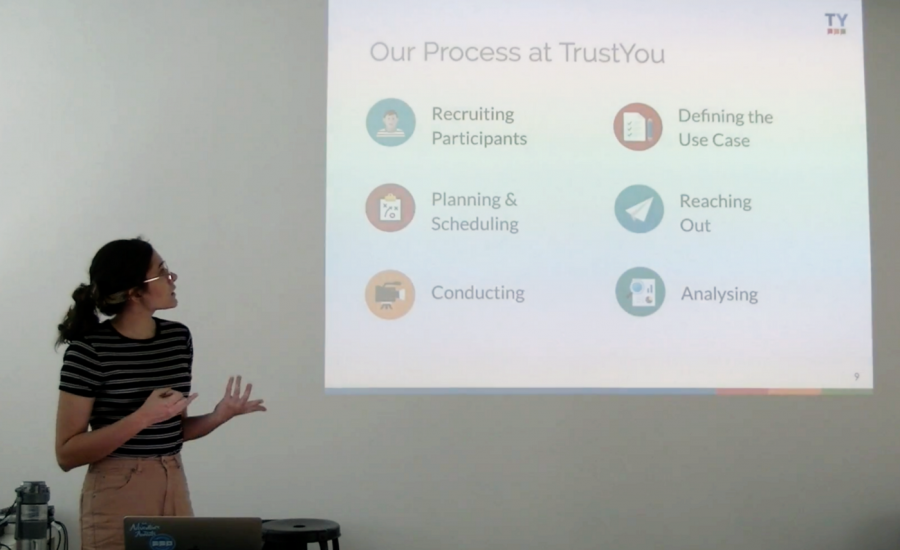This case study describes our challenges and learnings after defining a process and a set of tools in order to enable TrustYou to adopt user research practices. Shaping and improving this process was a project in which I worked closely with the Design and the Product teams, but also involved other departments that benefit from having a user centric approach. During my time at TrustYou, I also supported formative and evaluative research studies for several projects and initiatives.
As it is probably the case in many small and mid-sized companies, we started from the point in which there were already some research projects and initiatives conducted independently by some teams. The real challenge was to establish a process and a toolchain that could be used by anyone, and a centralised place to contain and connect all our findings and discoveries.
Understanding the Current State
Collaborating with other teams and departments to determine a starting point.
Cross-department Collaboration
The very first step in this project was to gather all our existing material and information regarding user research and previous initiatives that were conducted independently by different teams such as Marketing, Customer Success, Engineering and Product. This was also helpful to start having conversations to generate interest on the topic among some of my colleagues, who could later on be part of a dedicated research team.
Although the majority of my colleagues were aware of what user research meant, it’s always useful to know which other similar or close methodologies are used in fields that are not specifically user experience or product design. Most probably, if you ask your Marketing team, they might have some personas, case studies or market studies that although are made for other purposes, could serve as a good way to understand how you could reach out to some customers. Another good starting point might be checking with your customer success team in case they have any qualitative information from support tickets, NPS surveys or any other channels that they use for talking to your users. This could reveal some recurrent issues, requests or pain points that you can start documenting as part of user feedback.
Research Pillars
After getting a better picture of the current state of user research practices at TrustYou, we established some initial categories as the main pillars of user research, based on initiatives and projects that were done in different channels and managed by different teams.
Each of these research pillars was documented inside our Confluence space, including existing resources and material for each of them, which at that moment were scattered across different tools and Google Drive folders. By doing this, we started bringing all the different “sources of truth” into one single place that was available to everyone in the company.

Consolidating a Process
Establishing our different user research stages, tools and methodologies.
Workflow and Toolchain
One of the main reasons why research was happening in separated silos or even not done at all, was the lack of a standard process that was flexible enough to be adapted to different initiatives or project stages. After talking to some teams, I also understood that for some of them user research was a time consuming and expensive process that could not adapt to an agile environment. Based on this feedback, we worked to establish a process with a set of tools and methodologies that would make it easier to plan and conduct research by anyone in the company.
In this stage, we tried to leverage tools that were already used in the company, and combined them with three new ones that would allow us to have a solid and scalable process. These three tools were the following:

Calendly: This platform allowed us to set up time slots depending on the availability of the members of the research team, and generate a link that we could include in the research campaign, to let participants choose a time and a date that was suitable for them.

Dovetail: Dovetail opened up many possibilities for the company, as we started having a centralised place to plan and document the results of qualitative studies. It allowed us to better analyse, sort, and share results from user interviews and user testing.

UsabilityHub: After getting started with user interviews and usability esting for some of our projects, we discovered that we also needed to figure out a faster and easier way of testing designs and workflows, without the need of having controlled and lengthy research sessions. We then started using UsabilityHub to get quick feedback on not only visual design topics, but also navigation and information architecture.

Our Own User Research Pool
When I joined TrustYou, there was no structured process for reaching out to customers to involve them in research initiatives. Working together with other departments, we created a simple landing page in Mailchimp that was distributed through different channels, in order to ask our customers to be part of our user research initiatives. This allowed us to build a research pool of users that gave us consent to be contacted for future sessions.
An additional advantage that Mailchimp provided us, was the fact that we were able to tag users depending on their preferred language, or details such as which of them preferred to take part in studies that involved video or screen sharing, or only to fill in surveys or participate in unmoderated tests. This was very helpful since we could better plan different initiatives with different needs in terms of involvement of our participants.

Democratising Research
Empowering and encouraging other teams and colleagues to become researchers and join our initiatives and upcoming projects.
User Research Team
After establishing a more streamlined process and getting interest from different departments, we created a multidisciplinary research team, with members from Marketing, Customer Success, Sales, Engineering, Design and Product, to support ongoing and future projects and initiatives, and share resources and best practices. As part of consolidating the team, we also ran a couple of preparatory sessions in which we invited our members to participate in demo sessions that we usually ran before an actual test or interview.
Talks, Templates and Guidelines
As a way to create awareness and highlight the benefits of user research, we started sharing our initiatives through company-wide talks in which we explained the process, but also encouraged others to be part of our team.

We also made available a lot of resources such as templates and guidelines that would enable other teams to conduct their own research. Additionally, we established a research repository using Dovetail, in which everyone could get an overview of ongoing initiatives and check insights and findings from previous research projects.
Conclusions
After lots of trial and error, and continuously testing and learning different techniques to better gain insights from our users, but also to make our process more efficient, we decided to take a moment to reflect on what we have learnt and accomplished, and share it with others that might be going through a similar process, or that want to get started with user research at their current roles or projects.
As mentioned at the beginning, there are many cases in which there is actually a bit of research done here and there, but at the end, the key to really leverage it is to break those silos and make it available to everyone that could benefit from it. Although user research is an essential tool for designing products and services, it shouldn’t become an exclusive thing for product teams, and the process and toolkit can always be shaped to accommodate different needs and budgets. In our experience, closing the gaps between different teams and departments, and integrating tools that were already part of our daily work, were the crucial elements that helped us to not only build a multidisciplinary team to support our initiatives, but also to make user research agile, affordable and accessible to everyone.
· · ·
Thanks to the design team Radu Luchian and Lindsey Kuester for their trust and support on this project.


